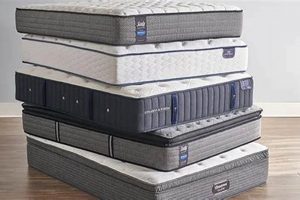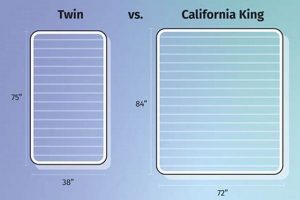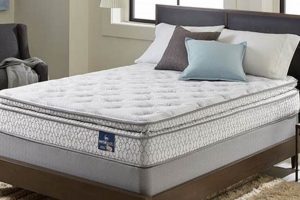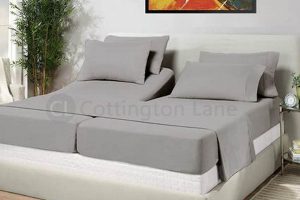A support structure designed to elevate and stabilize a king-sized mattress, this element typically consists of a rigid frame, often made of wood or metal, and may include a network of slats or a solid surface. It provides a level and firm base for the mattress, preventing sagging and ensuring proper weight distribution. As an example, one might find this support component used in a master bedroom to accommodate a large mattress for enhanced sleep quality.
The correct utilization of this base is paramount for maintaining the mattress’s structural integrity and extending its lifespan. Proper support prevents premature wear and tear, contributing to a more comfortable sleep experience and minimizing the risk of back pain or discomfort. Historically, these supporting structures have evolved from simple wooden frames to sophisticated designs incorporating advanced materials and engineering principles.
The ensuing sections will delve into the various types of these bed support systems, exploring the materials used in their construction, offering guidance on selecting the appropriate option for specific needs, and addressing common issues related to their maintenance and lifespan.
Guidance on King Size Mattress Foundations
Optimal selection and maintenance of a king size mattress foundation are crucial for sleep quality and mattress longevity. Consider the following recommendations:
Tip 1: Assess Mattress Compatibility: The chosen foundation must be compatible with the mattress type. Innerspring mattresses may perform adequately on a slatted or box-spring foundation, while memory foam or latex mattresses often require a solid, flat surface for proper support.
Tip 2: Evaluate Support Structure: A robust support structure is paramount. Inspect the foundation’s frame for sturdiness and the slat spacing (if applicable) to ensure adequate weight distribution. Insufficient support can lead to mattress sagging and premature wear.
Tip 3: Measure Room Dimensions: Before purchasing, accurately measure the bedroom space to ensure the foundation and mattress comfortably fit, allowing for adequate movement and visual appeal.
Tip 4: Consider Height Preferences: Foundation height influences the overall bed height. Evaluate personal preferences and physical limitations when determining the appropriate foundation height. Lower profiles can facilitate easier access, while taller profiles can provide under-bed storage space.
Tip 5: Inquire About Warranty: Review the foundation’s warranty terms. A comprehensive warranty protects against manufacturing defects and structural failures, offering long-term peace of mind.
Tip 6: Inspect for Quality Materials: Opt for foundations constructed from durable, high-quality materials, such as solid wood or reinforced steel. These materials ensure the foundation can withstand the weight of the mattress and occupants over time.
Tip 7: Prioritize Proper Assembly: Adhere meticulously to the manufacturer’s assembly instructions. Incorrect assembly can compromise the foundation’s structural integrity and potentially void the warranty.
Proper attention to these details when selecting and using this base can significantly enhance the sleep experience and prolong the lifespan of the accompanying mattress, safeguarding the investment in restful sleep.
The subsequent section will address common issues encountered with these support systems and offer practical solutions for their resolution.
1. Support and Stability
The support and stability provided by a king size mattress foundation are fundamental to ensuring both the longevity of the mattress and the comfort of the sleeper. A properly designed foundation distributes weight evenly, preventing sagging and maintaining the mattress’s structural integrity over time. This, in turn, contributes to proper spinal alignment and reduces pressure points during sleep.
- Weight Distribution
A primary function is the even distribution of weight across the entire mattress surface. This prevents localized stress and compression, which can lead to premature wear and tear. For example, a foundation with insufficient support in the center may cause the mattress to sag, resulting in discomfort and potential back pain.
- Structural Integrity
The foundation must possess sufficient structural integrity to withstand the combined weight of the mattress and occupants. This is typically achieved through the use of durable materials and a robust construction. A weak or poorly constructed foundation may collapse or warp over time, compromising the stability of the entire sleep system.
- Motion Isolation
A stable foundation contributes to motion isolation, minimizing the transfer of movement between sleepers. This is particularly important for king-size mattresses, as they are often used by couples. A foundation that effectively absorbs and dampens movement ensures that one sleeper’s tossing and turning does not disturb the other.
- Foundation Type Influence
Different types of foundations offer varying degrees of support and stability. For instance, a solid platform foundation provides uniform support across the entire mattress, while a slatted foundation offers more targeted support. The choice of foundation type should be based on the specific requirements of the mattress and the preferences of the sleeper.
The interconnectedness of these facets underscores the critical role a quality king size mattress foundation plays in supporting both the mattress and the individuals using it. Properly engineered foundations enhance the sleep experience by promoting proper spinal alignment, minimizing motion transfer, and extending mattress lifespan through even weight distribution and unwavering structural integrity.
2. Frame Durability
Frame durability is a paramount consideration when evaluating a king size mattress foundation. The frame serves as the structural backbone, responsible for supporting the considerable weight of a king-size mattress and its occupants. Its ability to withstand prolonged use directly impacts the foundation’s lifespan and its capacity to provide adequate support.
- Material Composition and Longevity
The materials used in the construction of the frame significantly influence its durability. Solid hardwoods, reinforced steel, or a combination thereof are common choices. Hardwoods offer inherent strength and resistance to warping, while steel provides exceptional load-bearing capacity. Less durable materials, such as low-density particleboard, may compromise the frame’s structural integrity over time. For example, a frame constructed with solid wood may last for decades, while one made of inferior materials
may show signs of wear within a few years. - Joint Construction and Stability
The manner in which the frame’s components are joined together is crucial for maintaining stability. Dovetail joints, mortise-and-tenon joints, or reinforced metal brackets are indicative of quality construction. Weak or poorly executed joints can lead to instability, creaking, and eventual failure of the frame. This is evident in cases where a frame with loosely connected joints begins to wobble or sag under weight.
- Weight Capacity and Load Distribution
A durable frame must be capable of supporting the combined weight of the mattress and its occupants without deformation or failure. Manufacturers typically specify a weight capacity for their foundations. Exceeding this capacity can place undue stress on the frame, leading to premature wear and potential collapse. The design should also ensure even distribution of weight to prevent localized stress points, thus preserving the frame’s overall integrity.
- Resistance to Environmental Factors
Frame durability extends to its resistance to environmental factors such as humidity and temperature fluctuations. Materials prone to warping, cracking, or corrosion can compromise the frame’s structural integrity over time. Finishes or treatments that protect against these factors can significantly extend the frame’s lifespan. For instance, a steel frame with a powder-coated finish is less susceptible to rust and corrosion than an untreated steel frame.
The durability of a king size mattress foundation frame is inextricably linked to its ability to perform its primary function: providing stable and long-lasting support for the mattress and its users. A frame constructed with quality materials, robust joints, and a design that considers weight capacity and environmental factors will contribute to a more comfortable and supportive sleep experience, ultimately extending the lifespan of both the foundation and the mattress itself.
3. Height Profile
The height profile of a king size mattress foundation significantly impacts both the aesthetics and the ergonomics of the bed. The foundation’s height, when combined with the mattress thickness, determines the overall bed height, influencing ease of access and the visual proportions of the bedroom. For example, a low-profile foundation paired with a thick mattress can create a contemporary, minimalist aesthetic, while a taller foundation may provide additional under-bed storage space and a more traditional appearance. The selected height directly affects how easily individuals, especially those with mobility challenges, can get into and out of bed, making it a crucial factor in bedroom functionality. Disregarding height considerations can result in a bed that is either too low, leading to difficulty rising, or too high, posing a safety risk.
From a practical standpoint, the height profile can dictate storage capacity beneath the bed. A taller foundation offers more vertical space for storing items such as seasonal clothing, extra linens, or other personal belongings, effectively maximizing space utilization in smaller bedrooms. Conversely, a lower profile might be preferred to maintain a cleaner, less cluttered appearance, or to accommodate architectural features such as low windowsills. In design-conscious environments, the choice of foundation height contributes to the overall room aesthetic, influencing the perceived size and style of the space. For instance, a platform bed with an integrated, low-profile foundation can create the illusion of more open space, while a traditional bed frame with a taller foundation evokes a sense of formality and grandeur.
In conclusion, the height profile of a king size mattress foundation is not merely an aesthetic consideration but a functional element that directly affects ease of use, storage capacity, and the overall visual harmony of the bedroom. Careful consideration of individual needs, spatial constraints, and desired style is essential to selecting a foundation with a height profile that optimizes both comfort and aesthetics. The challenge lies in balancing these factors to create a sleep environment that is both visually appealing and ergonomically sound, ultimately contributing to improved sleep quality and overall well-being.
4. Mattress Compatibility
The selection of an appropriate king size mattress foundation hinges critically on mattress compatibility. The foundation’s design and construction must align with the specific requirements of the mattress to ensure optimal support, longevity, and sleep comfort. Mismatched combinations can lead to premature mattress wear, inadequate support, and compromised sleep quality.
- Innerspring Mattress Support Requirements
Innerspring mattresses generally benefit from a stable, moderately firm foundation. Traditional box springs, slatted foundations with minimal spacing, or platform beds can provide adequate support. Excessive spacing between slats may allow the innerspring mattress to sag, reducing its lifespan. A well-chosen foundation prevents coil distortion and maintains the mattress’s overall structure.
- Memory Foam and Latex Mattress Needs
Memory foam and latex mattresses require a solid, even surface to prevent deformation. Slatted foundations with wide gaps or traditional box springs may not provide sufficient support, leading to uneven wear and tear. Platform beds or solid-surface foundations are generally recommended to ensure proper weight distribution and prevent sagging. This type of support is essential for maintaining the mattress’s conforming properties and pressure-relieving benefits.
- Hybrid Mattress Considerations
Hybrid mattresses, which combine innerspring coils with memory foam or latex layers, necessitate a foundation that caters to both components. A slatted foundation with closely spaced slats or a platform bed typically provides the necessary support. It’s crucial to ensure that the foundation can bear the weight of the mattress without compromising the individual benefits of its constituent materials.
- Adjustable Base Compatibility
If an adjustable bed frame is desired, the mattress must be specifically designed for adjustable base compatibility. Traditional innerspring mattresses are generally unsuitable for adjustable bases due to their rigid construction. Memory foam, latex, and specifically designed hybrid mattresses offer the necessary flexibility to conform to the adjustable base’s contours without damage. The foundation’s compatibility directly affects the adjustable base’s functionality and the user’s comfort.
In conclusion, the selection of a king size mattress foundation must be informed by the specific characteristics of the mattress it supports. Ignoring the compatibility factors outlined above can compromise the mattress’s performance, reduce its lifespan, and negatively impact the quality of sleep. Careful consideration of these elements ensures that the foundation and mattress work together harmoniously to provide optimal support and comfort.
5. Assembly Quality
er>
The assembly quality of a king size mattress foundation directly influences its structural integrity and long-term performance. Improper assembly can negate the benefits of high-quality materials and design. A poorly assembled foundation, even if constructed from durable components, is susceptible to premature failure, instability, and reduced support. For instance, if screws are not adequately tightened or if connecting joints are misaligned, the foundation may creak, wobble, or even collapse under the weight of the mattress and occupants. This directly impacts sleep quality and necessitates costly repairs or replacements. A real-life scenario involves a foundation where the corner brackets were not properly secured during assembly, leading to the frame warping within a few months, rendering it unusable. Therefore, meticulous attention to assembly protocols is essential for realizing the intended lifespan and functionality of the foundation.
The significance of proper assembly extends beyond mere structural stability. Correctly assembled components contribute to even weight distribution across the foundation’s surface. Misaligned slats or improperly attached support beams can create localized stress points, causing the mattress to sag prematurely in specific areas. This uneven support degrades the mattress’s comfort and can lead to back pain or other physical discomfort. Moreover, correct assembly impacts the aesthetic appeal of the bed. A foundation with protruding screws, uneven joints, or a generally unkempt appearance detracts from the overall visual appeal of the bedroom. Therefore, thorough adherence to the manufacturer’s assembly instructions, or professional assembly services, are advisable.
In summary, assembly quality constitutes an indispensable component of a king size mattress foundation. Its influence extends from structural integrity and weight distribution to aesthetic appeal and long-term durability. Neglecting assembly protocols undermines the investment in a high-quality foundation and compromises sleep comfort. The challenge lies in ensuring that assembly procedures are executed with precision and attention to detail, thereby maximizing the foundation’s performance and lifespan. Ultimately, a well-assembled foundation provides reliable support, promotes restful sleep, and enhances the overall bedroom environment.
Frequently Asked Questions About King Size Mattress Foundations
This section addresses common inquiries and clarifies essential aspects concerning king size mattress foundations, providing concise and informative answers.
Question 1: What is the expected lifespan of a king size mattress foundation?
The lifespan of a king size mattress foundation varies depending on the materials used and the quality of construction. Generally, a well-constructed foundation can last between 7 to 10 years, or even longer with proper care and maintenance. Factors such as weight distribution and usage patterns also influence its longevity.
Question 2: What types of mattresses are compatible with a king size platform foundation?
King size platform foundations are versatile and compatible with various mattress types, including memory foam, latex, and hybrid mattresses. However, it’s crucial to ensure the platform provides adequate support and ventilation, particularly for memory foam mattresses that can retain heat. Innerspring mattresses are also compatible, but may require a protective layer to prevent damage from the platform’s surface.
Question 3: How does a king size split foundation differ from a standard foundation?
A king size split foundation consists of two separate pieces, each measuring approximately 39 inches in width. This design facilitates easier maneuverability through doorways and hallways, particularly in tight spaces. Functionally, a split foundation provides the same level of support as a standard one-piece foundation but offers increased convenience during transport and setup.
Question 4: What is the recommended weight capacity for a king size mattress foundation?
The recommended weight capacity for a king size mattress foundation typically ranges from 600 to 800 pounds. This capacity encompasses the combined weight of the mattress and the individuals sleeping on it. Exceeding the stated weight capacity can compromise the foundation’s structural integrity and lead to premature wear or failure.
Question 5: What are the potential benefits of using a box spring foundation with a king size mattress?
Box spring foundations can provide several benefits, including shock absorption, enhanced support, and increased mattress height. The coils within the box spring help to absorb movement and distribute weight evenly, potentially extending the mattress’s lifespan. However, box springs are not always compatible with all mattress types, particularly memory foam or latex, which may require a solid platform for optimal support.
Question 6: How should a king size mattress foundation be properly maintained?
Proper maintenance of a king size mattress foundation involves regular inspection for signs of wear or damage, such as sagging or loose components. Rotating the foundation periodically can help to distribute weight evenly and prevent localized wear. Additionally, keeping the foundation clean and free from dust or debris can contribute to its longevity. Avoiding excessive weight or impact on the foundation is also essential.
Key takeaways from this FAQ section emphasize the importance of selecting a foundation compatible with the mattress type, understanding weight capacity limitations, and implementing routine maintenance practices to prolong the foundation’s lifespan.
The subsequent section will delve into potential issues that may arise with these foundations and offer practical solutions for addressing them.
Conclusion
This exploration of the king size mattress foundation has underscored its pivotal role in ensuring optimal sleep support and extending the lifespan of the corresponding mattress. The discussion encompassed critical considerations such as frame durability, height profile, mattress compatibility, and assembly quality, each contributing to the overall performance and longevity of the sleep system. A properly selected and maintained foundation mitigates premature wear, promotes even weight distribution, and ultimately enhances the quality of rest.
Given the significant investment associated with a king-size mattress, prudent selection and diligent maintenance of the foundation are paramount. Informed decision-making, guided by an understanding of individual needs and the specific requirements of the mattress, is essential for maximizing the value and longevity of the entire sleep ensemble. Therefore, careful consideration of the factors outlined herein is strongly encouraged to safeguard this investment and ensure restful sleep for years to come.




![Buy Beautyrest Silver Mattress King: [YEAR] Comfort! Organic & Natural Mattress Buyer’s Guide: Non-Toxic Sleep Solutions Buy Beautyrest Silver Mattress King: [YEAR] Comfort! | Organic & Natural Mattress Buyer’s Guide: Non-Toxic Sleep Solutions](https://mattressworldpa.com/wp-content/uploads/2025/07/th-8212-300x200.jpg)


